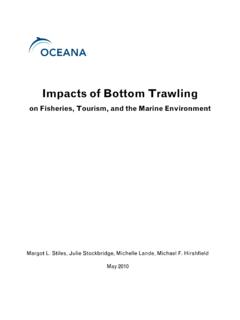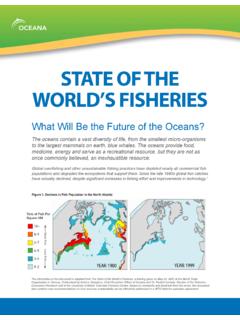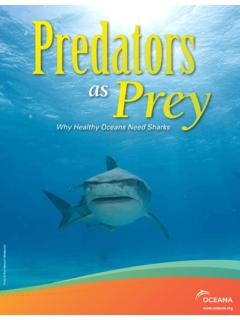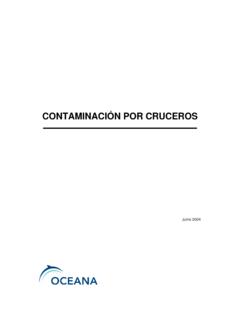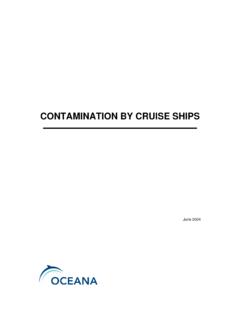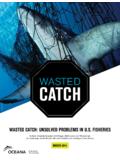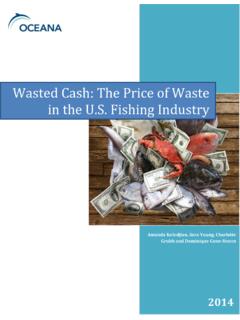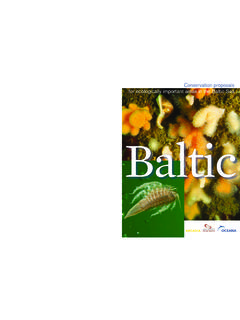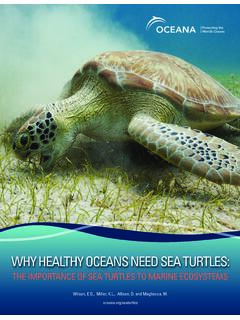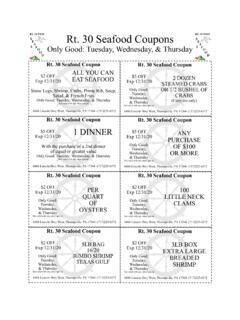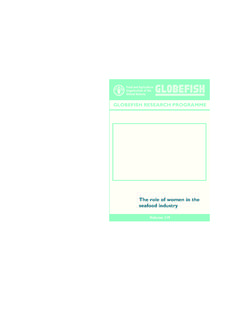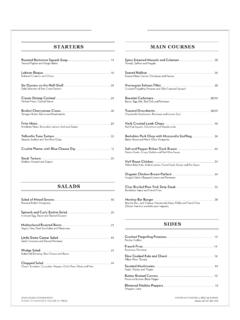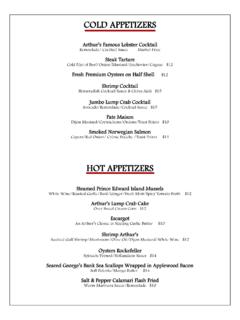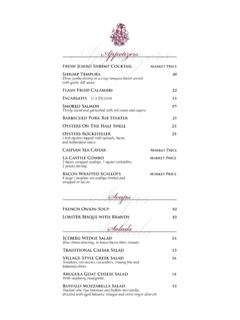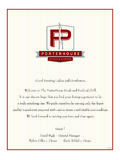Transcription of Oceana Study Reveals Seafood Fraud Nationwide
1 Oceana Study Reveals Seafood Fraud Nationwide February 2013. Authors: Kimberly Warner, , Walker Timme, Beth Lowell and Michael Hirshfield, Executive Summary Americans are routinely urged to include more Seafood in their diets as part of a healthy lifestyle. Yet consumers are often given inadequate, confusing or misleading information about the Seafood they purchase. The dishonest and illegal practice of substituting one Seafood species for another, or Seafood Fraud , has been uncovered both in the United States and abroad at levels ranging from 25 to more than 70 percent for commonly swapped species such as red snapper, wild salmon and Atlantic cod. From 2010 to 2012, Oceana conducted one of the largest Seafood Fraud investigations in the world to date, collecting more than 1,200 Seafood samples from 674 retail outlets in 21 states to determine if they were honestly labeled. DNA testing found that one-third (33 percent) of the 1,215 samples analyzed Nationwide were mislabeled, according to Food and Drug Administration (FDA) guidelines.
2 Of the most commonly collected fish types, samples sold as snapper and tuna had the highest mislabeling rates (87 and 59 percent, respectively), with the majority of the samples identified by DNA. analysis as something other than what was found on the label. In fact, only seven of the 120 samples of red snapper purchased Nationwide were actually red snapper. The other 113 samples were another fish. Halibut, grouper, cod and Chilean seabass were also mislabeled between 19 and 38 percent of the time, while salmon was mislabeled 7 percent of the time. Forty-four percent of all the retail outlets visited sold mislabeled fish. Restaurants, grocery stores and sushi venues all sold mislabeled fish and chances of being swindled varied greatly depending on where the Seafood was purchased. Our Study identified strong national trends in Seafood mislabeling levels among retail types, with sushi venues ranking the highest (74 percent), followed by restaurants (38.)
3 Percent) and then grocery stores (18 percent). These same trends among retail outlets were generally observed at the regional level. Seafood substitutions included species carrying health advisories ( king mackerel sold as grouper;. escolar sold as white tuna), cheaper farmed fish sold as wild ( tilapia sold as red snapper), and overfished, imperiled or vulnerable species sold as more sustainable catch ( Atlantic halibut sold as Pacific halibut). Our testing also turned up species not included among the more than 1,700 Seafood species the federal government recognizes as sold or likely to be sold in the As our results demonstrate, a high level of mislabeling Nationwide indicates that Seafood Fraud harms not only the consumer's pocket book, but also every honest vendor or fisherman along the supply chain. These fraudulent practices also carry potentially serious concerns for the health of consumers, and for the health of our oceans and vulnerable fish populations.
4 1. Because our Study was restricted to Seafood sold in retail outlets, we cannot say exactly where the fraudulent activity occurred. The global Seafood supply chain is increasingly complex and obscure. With lagging federal oversight and minimal government inspection despite rising fish imports, and without sampling along the supply chain, it is difficult to determine if Fraud is occurring at the boat, during processing, at the wholesale level, at the retail counter or somewhere else along the way. Our findings demonstrate that a comprehensive and transparent traceability system one that tracks fish from boat to plate must be established at the national level. At the same time, increased inspection and testing of our Seafood , specifically for mislabeling, and stronger federal and state enforcement of existing laws combatting Fraud are needed to reverse these disturbing trends. Our government has a responsibility to provide more information about the fish sold in the , as Seafood Fraud harms not only consumers'.
5 Wallets, but also every honest vendor and fisherman cheated in the process--to say nothing of the health of our oceans. 2. Table of Contents Part I: Nationwide Study Introduction>>>>>>>>>>>>>>>>>>>>>>. 4. Methods >>>>>>>>>>>>>>>>>>>>.. 4. Results and Discussion>>>>>>>>>>>>>>>>>. 5. Top Fish Types Collected and Mislabeled By Retail Outlet >>>>>>>>>>>>>>>>>>.. 8. By Geographic Location >>>>>>>>>>>>.. 9. By Fish: Snapper >>>>>>>>>>>>>>>.. 12. Tuna >>>>>>>>>>>>>>>>>>>>>. 16. Salmon >>>>>>>>>>>>>>>>>>>> 17. Cod >>>>>>>>>>>>>>>>>>>>>.. 19. Grouper >>>>>>>>>>>>>>>>>>>> 20. Chilean Seabass >>>>>>>>>>>>>>>>. 22. Halibut >>>>>>>>>>>>>>>>>>>>. 22. Sole >>>>>>>>>>>>>>>>>>>>>. 23. Yellowtail >>>>>>>>>>>>>>>>>>> 24. Summary >>>>>>>>>>>>>>>>>>>>>>.. 25. Conclusions >>>>>>>>>>>>>>>>>>>>>. 27. What Consumers Can Do >>>>>>>>>>>>>>>.. 28. Acknowledgments >>>>>>>>>>>>>>>>>>> 28. Part II: Regional Studies Large Studies Portland, OR >>>>>>>>>>>>>>>>>>>>>>>>> 29.
6 Seattle, WA >>>>>>>>>>>>>>>>>>>>>>>>>. 32. Northern California >>>>>>>>>>>>>>>>>>>>>>. 35. Southern California >>>>>>>>>>>>>>>>>>>>>> 38. Chicago, IL >>>>>>>>>>>>>>>>>>>>>>>>>.. 41. MN, WI. Boston, MA >>>>>>>>>>>>>>>>>>>>>>>>>. 44. New York, NY >>>>>>>>>>>>>>>>>>>>>>>>. 47. Washington, DC >>>>>>>>>>>>>>>>>>>>>>>. 49. South Florida >>>>>>>>>>>>>>>>>>>>>>>>.. 52. Medium Studies Kansas City, MO/KS>>>>>>>>>>>>>>>>>>>>>> 55. Austin/Houston, TX >>>>>>>>>>>>>>>>>>>>>>. 57. Denver, CO >>>>>>>>>>>>>>>>>>>>>>>>>.. 59. Santa Fe, NM. Small Studies Atlanta, GA >>>>>>>>>>>>>>>>>>>>>>>>>. 61. Pittsburg, PA >>>>>>>>>>>>>>>>>>>>>>>>.. 63. Endnotes (Part 1) >>>>>>>>>>>>>>>>>>>>>>.. 65. 3. Part 1: National Study Introduction Today, Seafood is a popular and healthy food choice for many Americans, making the the second 1. (only behind China) largest Seafood consumer worldwide. The American Heart Association and new dietary guidelines from the government both recommend eating eight ounces, or two Seafood meals, 2,3.
7 A week. However, Seafood consumers are often given insufficient, confusing or misleading information 4. about the fish they purchase. Seafood Fraud encompasses any illegal activity that misrepresents the fish you purchase, including mislabeling or substituting one species for another. Previous studies suggest that Seafood Fraud is more widespread than generally thought, both in the and around the world. Broad retail market surveys of Seafood mislabeling by both government agencies and academic researchers in North America have 5,6,7. uncovered mislabeling rates ranging from 25 to 40 percent. Outside the , mislabeling rates as 8,9,10,11. high as 50 percent have been found in broad surveys. Surveys of one kind of fish have found mislabeling rates of 25 to more than 70 percent for commonly swapped species such as red snapper, wild 12,13,14. salmon and Atlantic cod. Due to an increasingly complex supply chain, it is often unclear where and when Seafood Fraud actually takes place.
8 Seafood is a global commodity and is one of the most commonly traded food items in the 15 16. world. When more than 90 percent of the Seafood consumed in the is imported, and less than 1. 17. percent is inspected by the government specifically for Fraud , the opportunities for dishonest and illegal 18. practices abound. With more than 1,700 different species of Seafood now available for sale in the , it is unrealistic to expect the American consumer to be able to independently and accurately determine what fish is really being served. When considering that most Seafood purchased is in fillet form or already prepared in sauce, it can become even more difficult to distinguish between species. Some mislabeling may result from human error in identifying fish or their origin. More often, it is driven by economic gain, as when a cheaper or more readily available species is substituted for one that is more expensive, desirable or in limited supply.
9 This type of Fraud not only cheats the consumer, but it also hurts honest fishermen and Seafood suppliers who play by the rules. Mislabeling can also provide cover and profit for illegal or unregulated Seafood . Illegal fishing harms our oceans when threatened, overfished or undersized species are caught using restricted or banned fishing gear that destroys essential fish habitat and prevents species or stocks from recovering and thriving. Lastly, Seafood Fraud can have serious health consequences when mislabeled Seafood masks undeclared allergens, contaminants or toxins. 19,20. Methods From 2010 to 2012, Oceana staff and supporters purchased 1,247 Seafood samples from 674 retail outlets in major metropolitan areas in 21 states. More than 350 Oceana supporters volunteered to purchase Seafood items in select cities. Supporters were encouraged to purchase targeted fish of interest, such as fish species that had been found to be mislabeled in other studies and those with regional significance.
10 All samples submitted, including targeted and non-targeted fish, were analyzed using DNA methods. The 674 retail outlets consisted of restaurants, sushi venues, grocery stores and Seafood markets. More than one Seafood sample was obtained from many of the retail outlets visited, resulting in numerical 4. differences in the number of outlets visited and samples collected. Staff selected many of the restaurants and sushi venues visited by searching menus of retail outlets listed in Zagat and Yelp for the fish types of interest. Grocery stores and markets were selected mostly at random or based on convenience of staff and supporters. Most of the Seafood samples were analyzed at the University of Guelph's Canadian Centre for DNA. 21. Barcoding in Ontario, Canada. The University uses DNA barcoding, a genetic technique they pioneered, to identify the true species of each sample. This technique involves obtaining a short DNA.
